Case Study: Evaluating Financial Decision-Making at XYZ plc.
VerifiedAdded on 2023/01/06
|7
|1075
|93
Case Study
AI Summary
This case study analyzes the financial decision-making process at XYZ plc, a budget hotel, focusing on whether to invest in a tech project or a laundrette pricing strategy. The analysis includes calculations of payback periods for both projects, determining that Project A has a shorter payback period. The study also calculates and compares the Net Present Value (NPV) of each project, with Project A having a higher NPV, indicating its greater financial viability. Furthermore, the case study considers both financial and non-financial variables, such as interest rates and economic development, to provide a comprehensive evaluation of the investment options. The conclusion highlights the importance of considering various factors, including NPV and payback period, in making sound business decisions.

Assessment
Paraphrase This Document
Need a fresh take? Get an instant paraphrase of this document with our AI Paraphraser
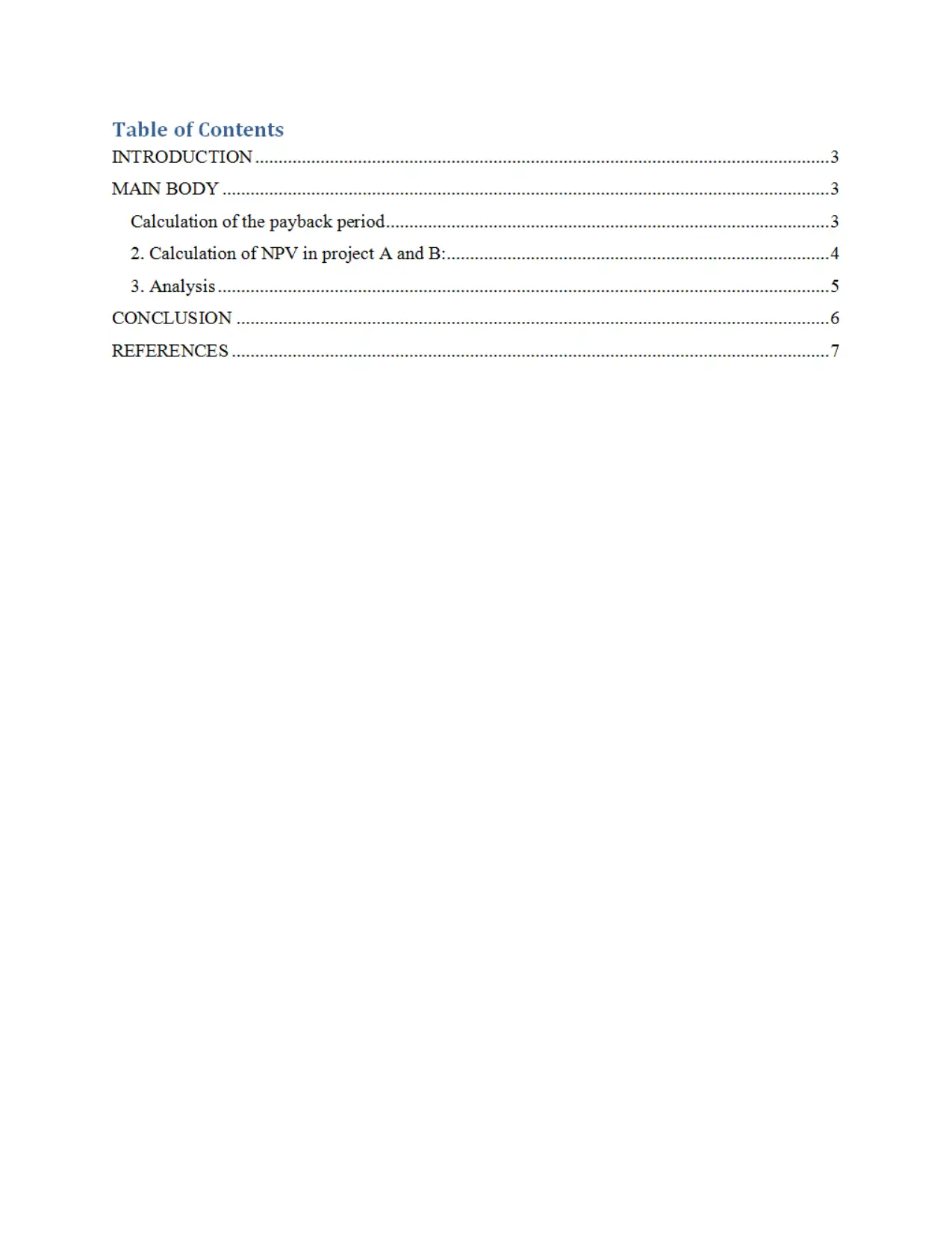
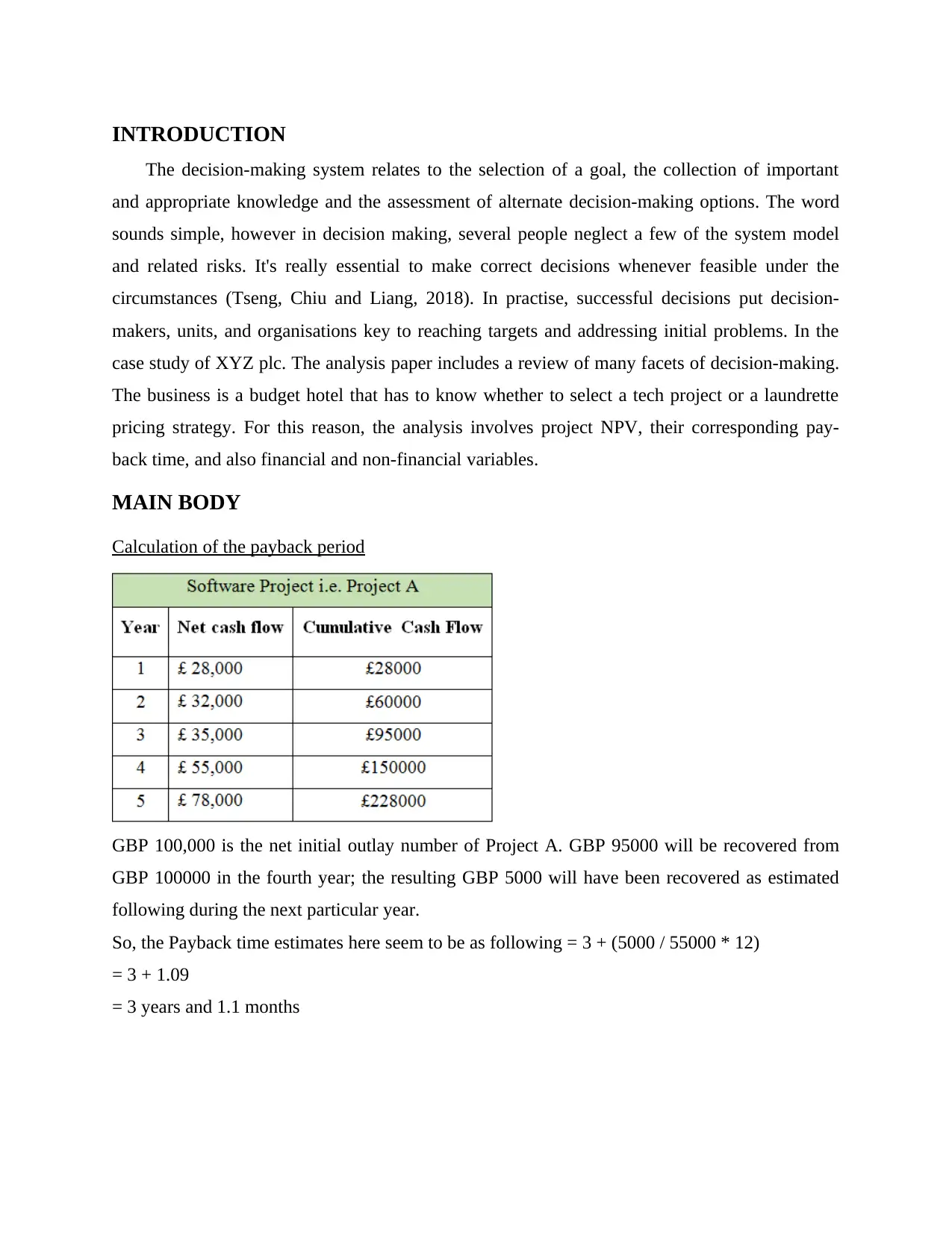
INTRODUCTION
The decision-making system relates to the selection of a goal, the collection of important
and appropriate knowledge and the assessment of alternate decision-making options. The word
sounds simple, however in decision making, several people neglect a few of the system model
and related risks. It's really essential to make correct decisions whenever feasible under the
circumstances (Tseng, Chiu and Liang, 2018). In practise, successful decisions put decision-
makers, units, and organisations key to reaching targets and addressing initial problems. In the
case study of XYZ plc. The analysis paper includes a review of many facets of decision-making.
The business is a budget hotel that has to know whether to select a tech project or a laundrette
pricing strategy. For this reason, the analysis involves project NPV, their corresponding pay-
back time, and also financial and non-financial variables.
MAIN BODY
Calculation of the payback period
GBP 100,000 is the net initial outlay number of Project A. GBP 95000 will be recovered from
GBP 100000 in the fourth year; the resulting GBP 5000 will have been recovered as estimated
following during the next particular year.
So, the Payback time estimates here seem to be as following = 3 + (5000 / 55000 * 12)
= 3 + 1.09
= 3 years and 1.1 months
The decision-making system relates to the selection of a goal, the collection of important
and appropriate knowledge and the assessment of alternate decision-making options. The word
sounds simple, however in decision making, several people neglect a few of the system model
and related risks. It's really essential to make correct decisions whenever feasible under the
circumstances (Tseng, Chiu and Liang, 2018). In practise, successful decisions put decision-
makers, units, and organisations key to reaching targets and addressing initial problems. In the
case study of XYZ plc. The analysis paper includes a review of many facets of decision-making.
The business is a budget hotel that has to know whether to select a tech project or a laundrette
pricing strategy. For this reason, the analysis involves project NPV, their corresponding pay-
back time, and also financial and non-financial variables.
MAIN BODY
Calculation of the payback period
GBP 100,000 is the net initial outlay number of Project A. GBP 95000 will be recovered from
GBP 100000 in the fourth year; the resulting GBP 5000 will have been recovered as estimated
following during the next particular year.
So, the Payback time estimates here seem to be as following = 3 + (5000 / 55000 * 12)
= 3 + 1.09
= 3 years and 1.1 months
⊘ This is a preview!⊘
Do you want full access?
Subscribe today to unlock all pages.

Trusted by 1+ million students worldwide
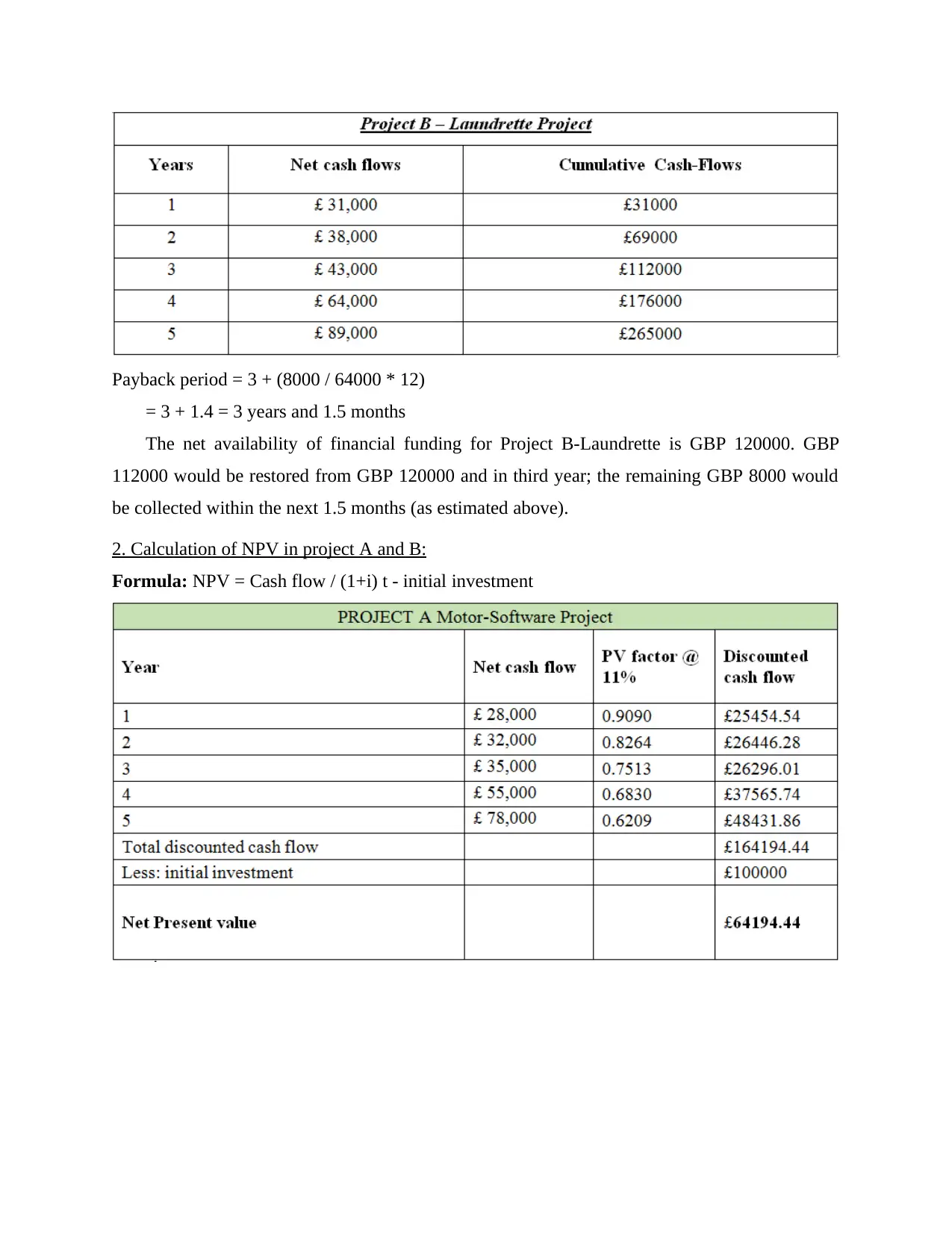
Payback period = 3 + (8000 / 64000 * 12)
= 3 + 1.4 = 3 years and 1.5 months
The net availability of financial funding for Project B-Laundrette is GBP 120000. GBP
112000 would be restored from GBP 120000 and in third year; the remaining GBP 8000 would
be collected within the next 1.5 months (as estimated above).
2. Calculation of NPV in project A and B:
Formula: NPV = Cash flow / (1+i) t - initial investment
= 3 + 1.4 = 3 years and 1.5 months
The net availability of financial funding for Project B-Laundrette is GBP 120000. GBP
112000 would be restored from GBP 120000 and in third year; the remaining GBP 8000 would
be collected within the next 1.5 months (as estimated above).
2. Calculation of NPV in project A and B:
Formula: NPV = Cash flow / (1+i) t - initial investment
Paraphrase This Document
Need a fresh take? Get an instant paraphrase of this document with our AI Paraphraser
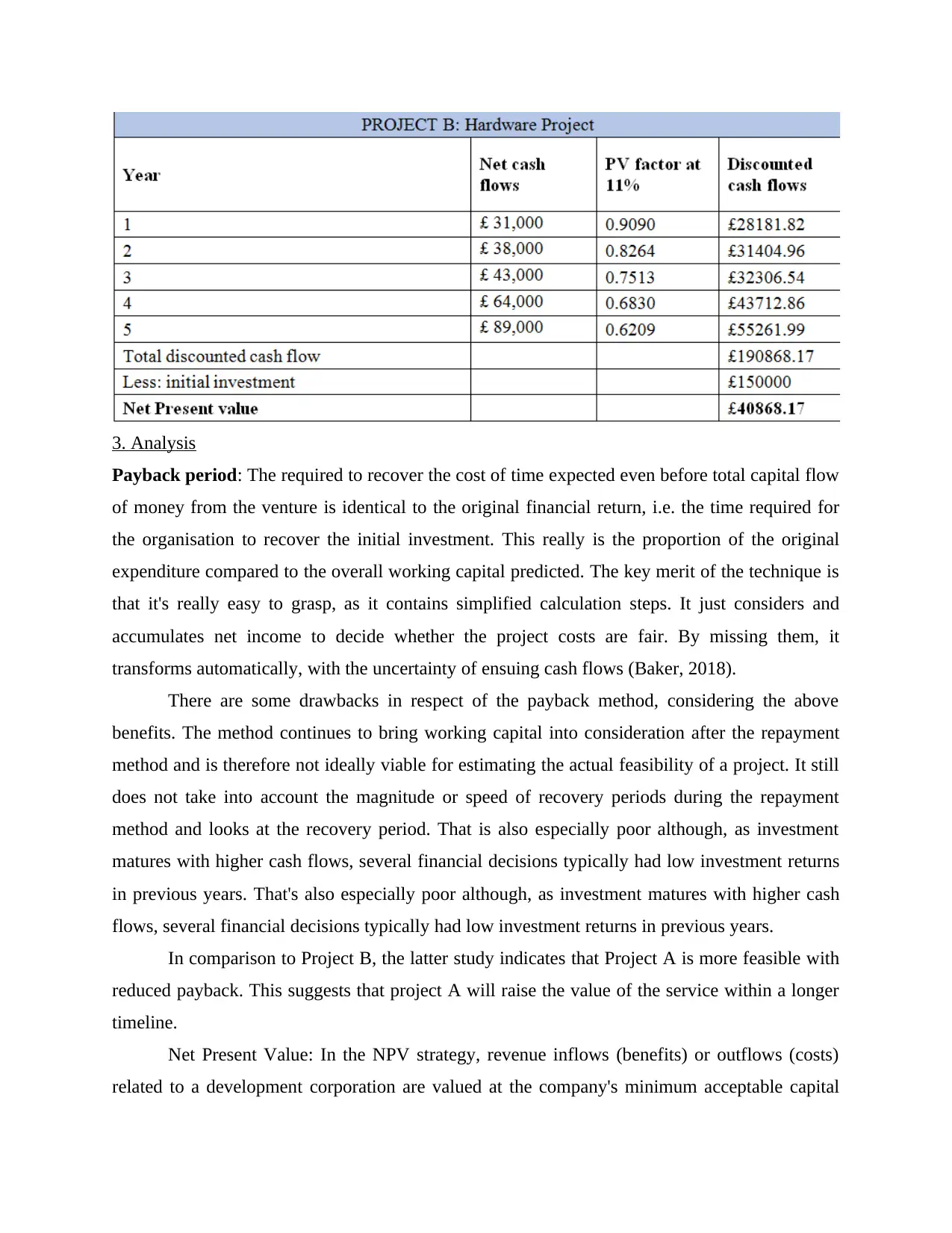
3. Analysis
Payback period: The required to recover the cost of time expected even before total capital flow
of money from the venture is identical to the original financial return, i.e. the time required for
the organisation to recover the initial investment. This really is the proportion of the original
expenditure compared to the overall working capital predicted. The key merit of the technique is
that it's really easy to grasp, as it contains simplified calculation steps. It just considers and
accumulates net income to decide whether the project costs are fair. By missing them, it
transforms automatically, with the uncertainty of ensuing cash flows (Baker, 2018).
There are some drawbacks in respect of the payback method, considering the above
benefits. The method continues to bring working capital into consideration after the repayment
method and is therefore not ideally viable for estimating the actual feasibility of a project. It still
does not take into account the magnitude or speed of recovery periods during the repayment
method and looks at the recovery period. That is also especially poor although, as investment
matures with higher cash flows, several financial decisions typically had low investment returns
in previous years. That's also especially poor although, as investment matures with higher cash
flows, several financial decisions typically had low investment returns in previous years.
In comparison to Project B, the latter study indicates that Project A is more feasible with
reduced payback. This suggests that project A will raise the value of the service within a longer
timeline.
Net Present Value: In the NPV strategy, revenue inflows (benefits) or outflows (costs)
related to a development corporation are valued at the company's minimum acceptable capital
Payback period: The required to recover the cost of time expected even before total capital flow
of money from the venture is identical to the original financial return, i.e. the time required for
the organisation to recover the initial investment. This really is the proportion of the original
expenditure compared to the overall working capital predicted. The key merit of the technique is
that it's really easy to grasp, as it contains simplified calculation steps. It just considers and
accumulates net income to decide whether the project costs are fair. By missing them, it
transforms automatically, with the uncertainty of ensuing cash flows (Baker, 2018).
There are some drawbacks in respect of the payback method, considering the above
benefits. The method continues to bring working capital into consideration after the repayment
method and is therefore not ideally viable for estimating the actual feasibility of a project. It still
does not take into account the magnitude or speed of recovery periods during the repayment
method and looks at the recovery period. That is also especially poor although, as investment
matures with higher cash flows, several financial decisions typically had low investment returns
in previous years. That's also especially poor although, as investment matures with higher cash
flows, several financial decisions typically had low investment returns in previous years.
In comparison to Project B, the latter study indicates that Project A is more feasible with
reduced payback. This suggests that project A will raise the value of the service within a longer
timeline.
Net Present Value: In the NPV strategy, revenue inflows (benefits) or outflows (costs)
related to a development corporation are valued at the company's minimum acceptable capital
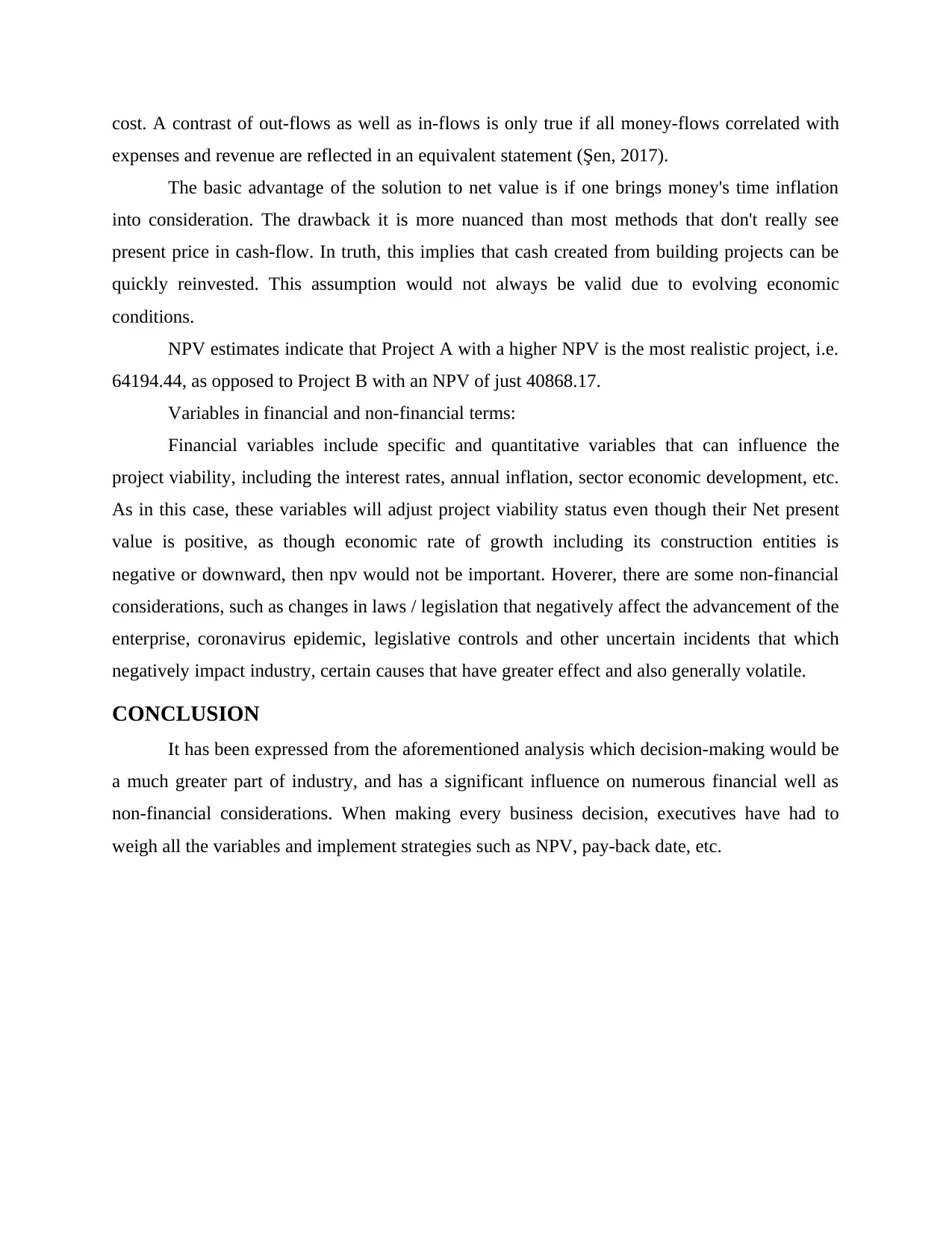
cost. A contrast of out-flows as well as in-flows is only true if all money-flows correlated with
expenses and revenue are reflected in an equivalent statement (Şen, 2017).
The basic advantage of the solution to net value is if one brings money's time inflation
into consideration. The drawback it is more nuanced than most methods that don't really see
present price in cash-flow. In truth, this implies that cash created from building projects can be
quickly reinvested. This assumption would not always be valid due to evolving economic
conditions.
NPV estimates indicate that Project A with a higher NPV is the most realistic project, i.e.
64194.44, as opposed to Project B with an NPV of just 40868.17.
Variables in financial and non-financial terms:
Financial variables include specific and quantitative variables that can influence the
project viability, including the interest rates, annual inflation, sector economic development, etc.
As in this case, these variables will adjust project viability status even though their Net present
value is positive, as though economic rate of growth including its construction entities is
negative or downward, then npv would not be important. Hoverer, there are some non-financial
considerations, such as changes in laws / legislation that negatively affect the advancement of the
enterprise, coronavirus epidemic, legislative controls and other uncertain incidents that which
negatively impact industry, certain causes that have greater effect and also generally volatile.
CONCLUSION
It has been expressed from the aforementioned analysis which decision-making would be
a much greater part of industry, and has a significant influence on numerous financial well as
non-financial considerations. When making every business decision, executives have had to
weigh all the variables and implement strategies such as NPV, pay-back date, etc.
expenses and revenue are reflected in an equivalent statement (Şen, 2017).
The basic advantage of the solution to net value is if one brings money's time inflation
into consideration. The drawback it is more nuanced than most methods that don't really see
present price in cash-flow. In truth, this implies that cash created from building projects can be
quickly reinvested. This assumption would not always be valid due to evolving economic
conditions.
NPV estimates indicate that Project A with a higher NPV is the most realistic project, i.e.
64194.44, as opposed to Project B with an NPV of just 40868.17.
Variables in financial and non-financial terms:
Financial variables include specific and quantitative variables that can influence the
project viability, including the interest rates, annual inflation, sector economic development, etc.
As in this case, these variables will adjust project viability status even though their Net present
value is positive, as though economic rate of growth including its construction entities is
negative or downward, then npv would not be important. Hoverer, there are some non-financial
considerations, such as changes in laws / legislation that negatively affect the advancement of the
enterprise, coronavirus epidemic, legislative controls and other uncertain incidents that which
negatively impact industry, certain causes that have greater effect and also generally volatile.
CONCLUSION
It has been expressed from the aforementioned analysis which decision-making would be
a much greater part of industry, and has a significant influence on numerous financial well as
non-financial considerations. When making every business decision, executives have had to
weigh all the variables and implement strategies such as NPV, pay-back date, etc.
⊘ This is a preview!⊘
Do you want full access?
Subscribe today to unlock all pages.

Trusted by 1+ million students worldwide
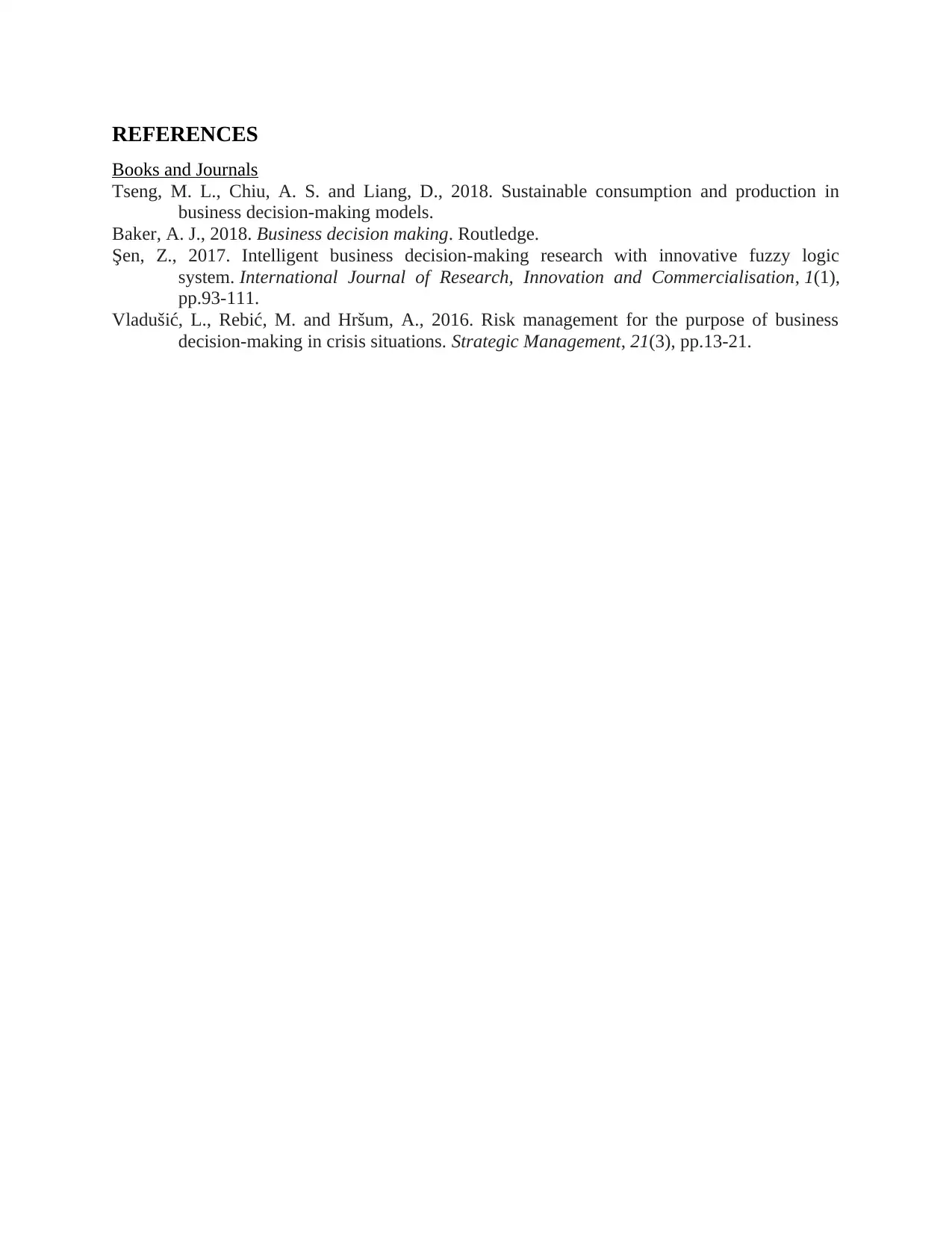
REFERENCES
Books and Journals
Tseng, M. L., Chiu, A. S. and Liang, D., 2018. Sustainable consumption and production in
business decision-making models.
Baker, A. J., 2018. Business decision making. Routledge.
Şen, Z., 2017. Intelligent business decision-making research with innovative fuzzy logic
system. International Journal of Research, Innovation and Commercialisation, 1(1),
pp.93-111.
Vladušić, L., Rebić, M. and Hršum, A., 2016. Risk management for the purpose of business
decision-making in crisis situations. Strategic Management, 21(3), pp.13-21.
Books and Journals
Tseng, M. L., Chiu, A. S. and Liang, D., 2018. Sustainable consumption and production in
business decision-making models.
Baker, A. J., 2018. Business decision making. Routledge.
Şen, Z., 2017. Intelligent business decision-making research with innovative fuzzy logic
system. International Journal of Research, Innovation and Commercialisation, 1(1),
pp.93-111.
Vladušić, L., Rebić, M. and Hršum, A., 2016. Risk management for the purpose of business
decision-making in crisis situations. Strategic Management, 21(3), pp.13-21.
1 out of 7
Related Documents
Your All-in-One AI-Powered Toolkit for Academic Success.
+13062052269
info@desklib.com
Available 24*7 on WhatsApp / Email
![[object Object]](/_next/static/media/star-bottom.7253800d.svg)
Unlock your academic potential
Copyright © 2020–2025 A2Z Services. All Rights Reserved. Developed and managed by ZUCOL.





